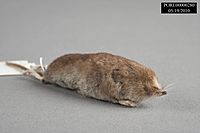Ornate shrew facts for kids
Quick facts for kids Ornate shrew |
|
|---|---|
 |
|
| Sorex ornatus relictus | |
| Conservation status | |
| Scientific classification | |
| Genus: |
Sorex
|
| Species: |
ornatus
|
 |
|
| Ornate shrew range | |
The ornate shrew (Sorex ornatus) is a tiny mammal that belongs to the shrew family. It lives only in western North America, from northern California in the United States down to Baja California in Mexico. There are eight known types, or subspecies, of the ornate shrew. One of these, the tule shrew (S. o. juncensis), is sadly extinct, meaning it no longer exists. Another, the Suisun ornate shrew (S. o. sinuosus), is a special concern for scientists trying to protect animals.
Scientists have studied ornate shrews using their skulls and DNA. They found three main groups of shrews: Southern, Central, and Northern. These groups formed because different populations of shrews became separated from each other over time.
Contents
What Does the Ornate Shrew Look Like?
Ornate shrews are very small animals. They weigh about 5 grams, which is less than a nickel! Their total length, from nose to tail tip, is about 10 centimeters (4 inches). Their hind feet are tiny, measuring about 1.2 centimeters. The tail is also quite short, around 3.7 centimeters long.
The shrew's fur changes color during the year. This process is called molting. In general, their fur is a dull brown on their back. It changes to gray or light brown on their belly. In winter, the fur on their back gets darker brown. Their belly fur becomes more grayish-white. Shrews that live further south tend to be a bit larger and have darker fur markings than those in the north.
The skull of an ornate shrew is about 1.6 centimeters long. Its overall shape is rather flat and wide. There is a small dip between where its eyes would be. The tail has two colors, gradually changing from brown on top to gray underneath.
Ornate Shrew Family Tree
Scientists group animals into families and subspecies to understand them better. The ornate shrew has several subspecies, which are like different types within the same species.
Subspecies of Ornate Shrew
Here are the different subspecies of the ornate shrew:
- Sorex ornatus juncensis (Tule shrew)
- Sorex ornatus lagunae
- Sorex ornatus ornatus
- Sorex ornatus relictus (Buena Vista Lake ornate shrew)
- Sorex ornatus salarius (Monterey ornate shrew)
- Sorex ornatus salicornicus (Salt marsh ornate shrew)
- Sorex ornatus sinuosus (Suisun ornate shrew)
- Sorex ornatus willetti (Santa Catalina ornate shrew)
Where Ornate Shrews Live
The ornate shrew lives along the west coast of North America. You can find them from northern California in the United States all the way down to the Baja California Peninsula in Mexico. They also live on a few islands close to the coast, like Santa Catalina Island. There have also been reports of them on Santa Cruz and Santa Rosa islands.
Ornate shrews like to live in coastal marshes and wet, swampy areas. Some subspecies might only be found in very specific types of habitats. These shrews have been found in mountains as high as 2,400 meters (about 7,900 feet) in the San Jacinto Mountains.
Ornate shrews used to be common in many places. However, their numbers have dropped a lot in sensitive areas. These include coastal wetlands, salt marshes, and freshwater swamps. They are also less common in parts of central California where there is a lot of farming.
Ornate Shrew Behavior and Life Cycle
Ornate shrews begin to have babies in late February. Their breeding season lasts until late September or October. Shrews of similar size usually carry their babies for about 21 days before they are born. However, scientists don't have exact information for the ornate shrew yet.
Protecting the Ornate Shrew
The International Union for Conservation of Nature (IUCN) says the ornate shrew is of "Least Concern." This means they believe the animal is not currently in danger of disappearing. They say this because the shrew lives in a wide area and its population seems stable enough.
However, the IUCN also notes that some groups of shrews in the Baja Peninsula might be at risk. This is due to human activities that destroy their homes and other environmental problems.
Sadly, the tule shrew, a subspecies of the ornate shrew, is now extinct. This means it has completely disappeared from Earth. The government of Mexico has special laws to protect ornate shrews. There are also protected areas in both Mexico and the United States where these shrews live. In exciting news, the Catalina shrew (S. ornatus willetti), another subspecies, was photographed in 2020 after not being seen for 15 years!
See also
 In Spanish: Musaraña ornamentada para niños
In Spanish: Musaraña ornamentada para niños




